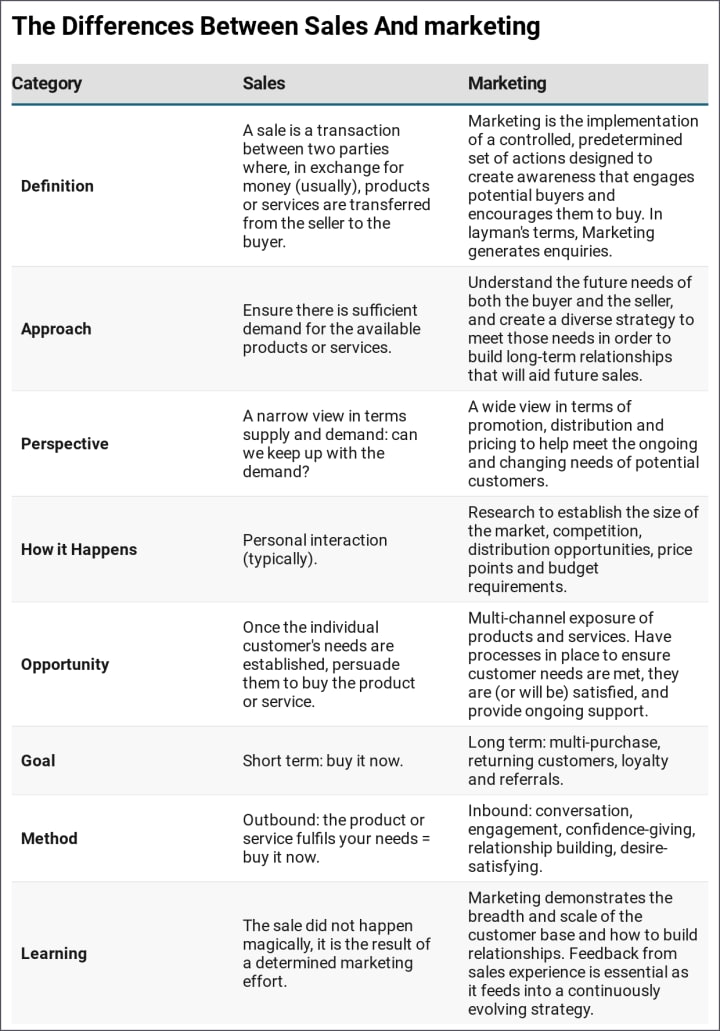The Difference Between Sales and Marketing
Breaking the love-hate relationship

It’s not uncommon for an element of tension to exist between the sales department and the marketing department, mainly because each has different goals and different methods of achieving them.
Whilst both departments work towards increasing revenue overall, typically, sales is all about the end result; the transaction. Marketing is all about the journey/long term view; awareness, credibility, relationship-building and engagement before, during and after they conclude a sale.
Given the activities and goals are so different, it’s odd that the term, ‘sales and marketing’ is [pretty well] universally adopted as though they’re the same. This is undoubtedly true in smaller companies, and there will always be an element of crossover between the two, but they are different.
And, whilst the phrase; ‘sales and marketing’ is easier to say than ‘marketing and sales’, the latter is more accurate because that’s the order in which it happens: marketing activity typically precedes sales.

The value of marketing
A sale rarely leads to another sale, or to an up-sell, without using marketing to add value.
Equally, some sales may appear to happen by themselves, especially with a long-term established product (think: chocolate). But without marketing activity in place to start the process and to keep the product in the minds of potential customers, sales are scarcer and less reliable.
Loyalty towards everything from local shops to big-name brands has all but disappeared. There are a couple of reasons for this: humans are notoriously forgetful and lazy, and the impact of 21st Century consumerism, where everything is available all the time from whoever offers the best value and can deliver it to us the quickest.
The best possible solution is to keep your products or services front and centre of your potential customers — you need to be visible anywhere they’re likely to look for what you [and your competitors] have on offer.
The big players, especially in consumer products, thoroughly understand the value marketing provides in maintaining product visibility. It’s why they have big budgets available to lavish on brand awareness.

To help clarify the fundamental differences between sales and marketing, the table below separates the functions within each discipline:

The chicken or the egg
The primary purpose of marketing is to pique interest that leads to enquiries. It’s at the point of enquiry that the sales department takes over to convert the enquirers into customers by completing the transaction.
Marketing activity can begin before a product even exists. It can be as much about determining the need for a product and the scale of the market opportunity before the product is in production, as it is about creating awareness and opportunity for an existing product.
Sales, however, can’t happen until there is a product to sell (unless taking pre-orders for a forthcoming launch) and a customer-base is there to buy it.
Marketing takes a wider view of attracting the interest of larger groups, while Sales focuses mainly on only those qualified to buy.

Understanding Price vs Value
Ultimately, the price is the amount of money a buyer pays to enable them to take away the product. However, the level of satisfaction associated with the amount paid is its perceived value, not its price.
The question of perceived value is a simple enough concept to grasp as we all experience it all the time. Whether we’re shopping for food, home electronics, holidays or cars, we misunderstand value. It is often abused by both Marketing and Sales — although way, way more by Sales!
Value is personal to the individual, which is why two people rarely perceive the same value in a product or service. The phrase: ‘value for money’ serves no purpose in moving a potential customer towards a sale because only they know what they value.
That said, it remains a stock phrase in marketing circles because humans are easy to trick. Why do we believe (and subsequently buy) the latest washing powder will wash our whites, whiter than white when that’s precisely what we believed the previous version would do? And the one before that. How much whiter can our clothes get?


The Sales approach to selling
Example: buying a second-hand car.
The gameplay that ensues when we go to buy a second-hand car is comical.
The customer’s mindset (focused on value and excitement): I have some idea of the car I want to buy, but I’m not yet certain. I have a flexible budget. I want to be wowed. I’m nervous but really excited. I can’t wait to take it for a drive and show it off to my friends and family.
The salesperson’s mindset (focused on price, not value): Here comes another prospect to buy a car. I need to establish the maximum they can afford and persuade them the price [of the vehicle] is right so I can close the deal and complete the sale.
The conversation begins with money and qualification: “how much are you looking to spend today?”, instead of value: “do you have a car type in mind, and how much difference will it make to you?”. The salesperson continues in a persuasive style that edges the buyer towards a sale, instead of playing to their desires by repeating their own words and phrases about their needs.
This is a buyer’s worst nightmare because the salesperson is not interested in what the buyer actually wants; why they need it or how excited they are by the prospect of owning a new car. The salesperson is interested only in closing the deal so they can move on to the next prospect and do it all over again.
The result is a buyer who feels uneasy, protective over how much they can afford (remember, this is not the same as how much they are prepared to spend because that’s based on perceived value), and will probably continue to look around or go elsewhere.
Most of us hate to be sold to.
The value approach
A far-more successful approach is based on understanding the buyer’s sense of value. Doing so can easily result in the customer leaving the showroom having bought a bigger, more expensive, higher-specification car than they originally intended, yet is both delighted and excited with their decision to buy.
They take photos of the car and can’t wait to tell their friends and family about the new car they’ll feel so proud to own. Why? Because of the value they placed on what they’re buying, not the cost of it. This is their perception of ‘value for money’. Not the salesman’s, and not yours.
We’ve all heard people say, “I know it’s a lot of money, but…” or, “I know I can’t really afford it, but…” when they’ve spent more on a purchase than they originally intended to, yet are still very happy they’ve done so. That’s because it was a value-based purchase.
Conversely, when we hear people say, “that’s expensive” or, “I’m not paying that much” this is rarely about the cost of the item because, what they actually mean, is, I don’t place a high enough value on that product to pay the asking price.
Some people don’t spend money on designer clothes, fine dining, jewellery or art, yet they travel abroad on family holidays, drive a nice car (or two) and have huge flat-screen TVs in their house. Their choices are simply a display of what they value the most. Spending £240 on a pair of designer jeans is no different. To the buyer, it represents excellent value for money because of how it makes them feel.

Setting out your stall
For a car showroom, marketing is demonstrated in several ways. These include organising the advertising; setting-up the window displays and signage; cleaning the cars inside and out to within an inch of their lives; putting up banners and posters.
It will also include making sure a variety of drinks are available; cleaning the forecourt, and making sure prospects feel really welcome and at ease so they want to come in and look around. It’s all about creating interest and drawing-in the lookers.
The sales department’s job is simply to convert the lookers into buyers and, when they drive their shiny new car home, the salesperson’s job is done. It’s a win-win.
But what about the welcome/information pack left in the car; the letter they receive a few days later thanking them for the purchase and wishing them many enjoyable miles; the refer-a-friend code that will pocket them £200 on a successful sale; the reminder sent when their car needs a service; the “any problems, we’re only a phone call away,” and so on? That’s all marketing, and it’s that long-term thinking which will create another opportunity for a second or third sale further down the line AND referrals.

Sales and Marketing teams working together
Nobody understands the mood of buyers like a front-line salesperson does.
They’re out there and in the moment, listening to prospects’ needs. They know what’s going on, and what people do and don’t want. Yet it’s so often the case that Marketing never thinks to ask Sales about this before they create a marketing campaign.
Equally, you’d think the sales department would be keen to ensure the marketing department is focusing its campaigns around the knowledge and information gained [by sales], to help make the sales process smoother.
Whether separate or combined, the two departments need to work together, holistically. It’s not meant to be a competition or one-upmanship.
Sales and marketing activities are very different and utilise diverse methods, techniques and language to achieve different goals.
Without salespeople to sell, there’s no point in carrying-out marketing. Without marketing activity to whet prospects’ appetite and pique their desire to buy, sales are much harder to achieve and will, potentially, be of lower value.

Key points to take away, whether you’re in sales or marketing
Keep in mind that you ultimately want the same thing, but that you’ll go about it in different ways.
Make friends with the other department and get them to help you.
Keep your egos out of it: share what you know and learn what they need.
Create campaigns together, not separately, so you both win big.
When the pandemic is over, shake hands. Until then, shake hands.

Originally published on Medium
About the Creator
Clive Wilson
I write with an inquiring mind about marketing, business and what life can teach us about life, and I take very little at face value.
You can find more about me at www.clivewilson.com






Comments
There are no comments for this story
Be the first to respond and start the conversation.